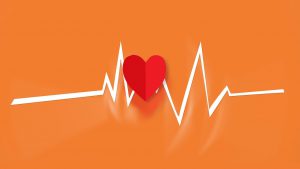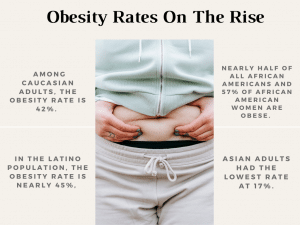What does it mean to be healthy? What if you’re rail-thin, but sedentary? Or how about if the scales say you’re overweight, or even obese, but you eat well and exercise? These questions, which essentially make up the “fat-but-fit” debate, have been controversial for a long time, especially when it comes to the question of whether you can be overweight and still healthy. And, unfortunately, there are still conflicting studies surrounding this issue, meaning it doesn’t look like the arguments are going to stop anytime soon. So maybe it’s time to reframe the debate anyway.
Conventional Wisdom on Obesity

Mainstream opinion seems to be that being overweight, or especially obese, automatically means being less healthy than being thinner. If we were going to boil down the conventional wisdom on the topic, we’d probably cite the research that finds strong associations between overweight and obesity and negative health effects, which is what most people think of. And it is true: there are a lot of high quality studies out there that have shown that obesity increases your risk of chronic diseases, such as heart disease, type 2 diabetes, cancer, premature death, breathing difficulties, nonalcoholic fatty liver disease, and mobility issues.
You might even be vaguely familiar with findings like the ones from one retrospective study including 103,218 people that observed a 1.5–2.7-fold greater risk of death among people with obesity, compared with those with “normal” weight statuses. Or you might have heard that excess belly fat can be a real killer – literally, since it leads to the highest rates of cardiovascular disease and metabolic syndrome.
How about a huge study from 2017, published in the Journal of the American College of Cardiology, that according to the lead author, found that “The bottom line is that metabolically healthy obesity doesn’t exist…Obesity is not a benign condition”? This study suggests that even when overweight or obese people are free from health complications, they are still more likely to develop heart disease than people who aren’t overweight, even if they don’t have conditions like diabetes, high blood pressure or high cholesterol (in other words, are “metabolically healthy obese”).
In this study, as long as they were in the obese weight category, participants had a higher risk for having a stroke, a nearly 50% greater risk of developing coronary heart disease, and had nearly double the risk of developing heart failure than people who were not overweight and in similar metabolic health. And if they were just overweight? They still had a 30% higher chance of developing coronary heart disease than other people.
But you know what? There’s always a “but.” So let’s take a look at some of the controversies in this debate, and the challenges to this conventional wisdom.
The Controversy
These studies are concerning, but the thing is they don’t actually always tell the whole story, both for better or for worse. First, let’s look at some of the caveats that are fueling the fat-but-fit controversy, and then at what might be the real reason that even being metabolically healthy but overweight could be problematic.
First of all, to take the study above as an example, it’s important to note that this major study that followed 3.5 million British people from 1995-2015 left a few important things out. It didn’t look at lifestyle, meaning that it fails to account for the effects of diet. Not only that, but as many studies do that look at weight, it classified weight status by using body mass index (BMI), a formula based on height and weight that doesn’t distinguish muscle from fat.
But here’s where we get to the real controversy. This study, like many others, didn’t take fitness level or physical activity into account. So yes, there is strong evidence that obese individuals have a higher rate of heart failure, but when it comes to coronary heart disease outcomes, studies that take both weight and physical fitness into account have concluded that “fitness is more important than fatness.”
Let’s take a look at another study from even more recently. It analyzed 527,662 people, and found that despite being regularly active, those with obesity had two, four, and fivefold greater risks of developing diabetes and high cholesterol and blood pressure than people with “normal” weight statuses.
Those scary stats are what most media outlets ran with, but there were other aspects to the study that were important, too. First, it found a reduced risk of chronic disease across all BMI categories in those who were more physically active, leading the authors to conclude that physical activity does, in fact, provide health benefits across all BMI categories. Second, it did not look at cardiorespiratory fitness, or diet, both of which are pretty important when it comes to assessing heart disease risk.
Now add to all of this these studies:
- 2 studies from 1999 that found that obese men could possibly reduce their risk of dying from heart disease more than threefold with regular exercise, even if they didn’t lose a single pound.
- A recent meta-analysis from 2014 that found that individuals with normal, overweight, and obese weight statuses with equal cardiorespiratory fitness levels had the same risk of all-cause mortality. Those who were unfit, regardless of their BMI, had a twofold greater risk of all-cause mortality.
- A 30-year follow-up study including 3,307 people that showed a 36% decreased risk of heart-disease-related mortality in those that remained physically active, with weight loss providing no additional risk reduction.
So what do we have? A recipe for a debate that doesn’t feel like it’s going to be wrapped up definitively anytime soon. But with that being said, there is, as we mentioned above, one more part of the debate that might tie these two sides together. The effect of remaining obese throughout your life, and not making lifestyle changes that could improve your health.
Time Takes Its Toll
According to a study on obesity and cardiovascular diseases published in the journal Minerva Medica, “The most effective therapies at reversing CVD [cardiovascular disease] risk factors associated with obesity have been dietary changes with exercise.” That simple sentence says a lot. The answer to the debate (if there is one) could be that being fat-but-fit is possible for a period in your life, but, like most good things, that state of being will eventually come to an end.
Remember that study published in the Journal of the American College of Cardiology, the one that left out a few things? It had another interesting finding, one that maybe wasn’t as widely publicized as its findings shattering the idea that you can be fat and fit. It found that, according to lead study author Joshua Bell, time was actually the most important factor in the participants’ health.
For example, 66 of the participants were considered “healthy obese adults” at the beginning of the study, but after 20 years, about half had progressed to unhealthy metabolic levels, even without any changes in weight. To these researchers, that meant that being currently healthy doesn’t guarantee being healthy down the road. The authors of the study suggest this is because excess fat is biologically active, messing with hormone balance and pumping out inflammatory chemicals, which can cause insulin resistance (a precursor to diabetes), cancer, and a lot of other bad things in between.
Interesting. So this could mean that yes, you can be fat but fit, but that designation is only a snapshot in time, and making healthy lifestyle changes now could mean avoiding all of those possible negative effects of obesity down the road. Is it time, then, to reframe the fat-but-fit debate?
Reframing the Debate
What’s the takeaway here? What’s most important? Probably not that researchers are arguing over whether it’s actually possible to be fat and fit at the same time, although keeping on top of the latest findings is a good idea. What’s really important is how you can be your healthiest self, now and in the future, and that could mean simply moving your body more, along with other healthy habits.
After all, focusing too much on someone’s weight takes away from other positive actions they’ve taken toward good health, like getting more exercise, managing stress, eating a nutritious diet, and sleeping more. In fact, making weight loss your goal can also be unhelpful: it’s much easier to set a goal to be more physically active than it is to set a goal for how many pounds you want to lose. For example, you can set a goal to get in a brisk 30 minute walk, three times a week, which feels much more doable than telling yourself you need to lose 20 pounds by a certain date.
What’s more, getting regular exercise is beneficial to everybody, regardless of weight, and increasing your cardiorespiratory fitness, strength, endurance, and flexibility is more important than focusing on aesthetic weight loss. You’ll get all of the benefits of moving your body more, including: 
- Stronger muscles and bones
- Lower risk of injury
- Reduced pain
- Better mood and brain health
- Improved sleep and energy levels
- Increased self-confidence and self-efficacy
- Improved productivity and creativity
- Reduced risk of chronic disease (e.g., heart disease, type 2 diabetes, and cancer)
- Lower risk of early death
- A healthier immune system
- A healthier heart
- Better quality of life
And once you get a taste of all that, you’ll want more! That means, no matter how much you weigh right now, you’ll be on the road to better health.






